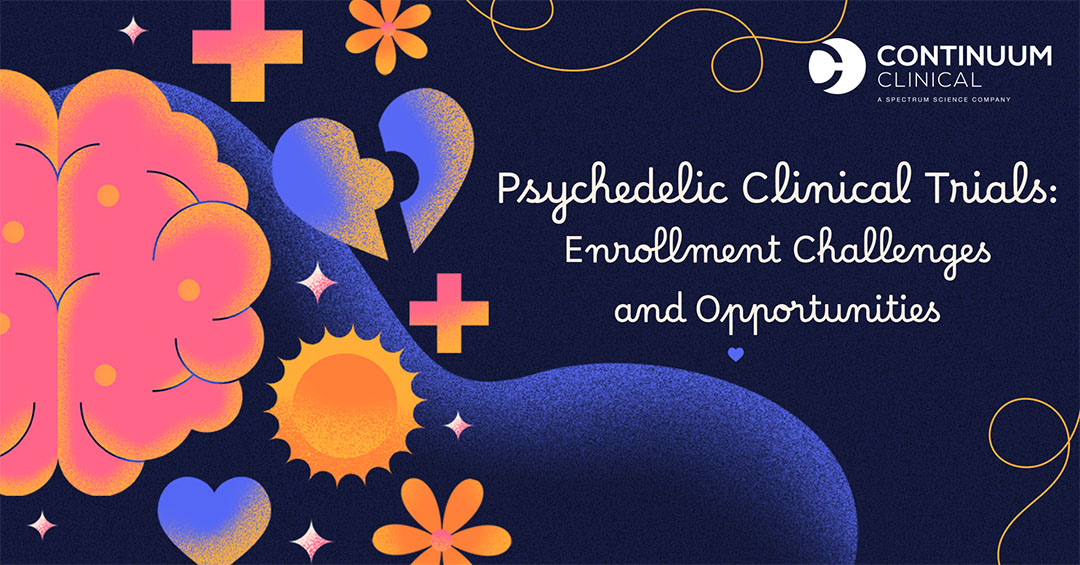By Neil Weisman, President, Continuum Clinical

When I first read Naked Lunch years ago, psychedelics were shrouded in counterculture mythology—tools of rebellion, introspection, and sometimes chaos. The book was wild and brilliant, but worlds away from my reality.
Three decades later, watching The Dead & Company deliver an epic performance in Las Vegas, I’m surrounded by immersive, digitally rendered psychedelia. It was hard not to notice that psychedelics have moved from taboo to mainstream.
While the perception of psychedelics has evolved, our understanding is still catching up, particularly in healthcare. And nowhere is that more evident than inside the clinical trials trying to validate them. So where are we now?
Though the public narrative is shaped by optimism, media buzz, and personal anecdotes, the clinical research reality is much more complex and filled with growing pains.
If psychedelic therapies are going to earn their place in modern medicine, we need to understand the truth. I’ve identified some common myths about psychedelic research and outlined what’s actually happening on the ground.
Myth #1: “People are lining up to join psychedelic trials”
Reality: Not exactly
Many of today’s psychedelic trials focus on conditions like treatment-resistant depression (TRD) and post-traumatic stress disorder (PTSD). Although urgent and underserved, they’re not mass-market diagnoses. The eligible population is smaller than it appears, and finding participants who meet strict trial criteria is challenging. This is a common challenge seen across neuroscience—like in stroke or spinal cord injury research. And it’s a reminder that scientific promise doesn’t guarantee recruitment success.
Myth #2: “These are just like any other CNS trial”
Reality: They’re operationally more intense
Dosing sessions can stretch across an entire day, with participants in altered states needing constant monitoring. Add to that the integration of psychotherapy, multi-step prep, and re-entry protocols, and you quickly outgrow what most investigator sites are built to handle. Traditional sites may have the scale but not the expertise; psychedelic-focused sites may have the mindset but not the infrastructure for late-phase trials. This mismatch underscores the need for thoughtful, tailored site expansion—not just more sites, but the right ones.
Myth #3: “Placebo controls work fine here too”
Reality: When the treatment itself alters perception, blinding gets blurry
Functional unblinding (when participants know they’re on placebo) introduces major retention risks. Participants may disengage or drop out when they believe they’re not receiving real treatment. That alone skew trial data. The FDA encourages active-control designs to mitigate this. Studies like the COMPASS Pathways Phase 2 trial reported variable outcomes based on dosage. That complexity demands equally nuanced trial design.
Myth #4: “Everyone enrolling believes in the science”
Reality: Not always
Some participants are drawn in by genuine need. Others by curiosity, or even a desire for a controlled psychedelic experience, or “psychedelic tourism.” While enthusiasm isn’t inherently bad, it can introduce expectation bias and skew efficacy results. To manage this, many trials cap prior psychedelic use and add layers of prescreening to assess participant motivation and eligibility before referral to a site.
Myth #5: “More trials mean faster progress”
Reality: The market is crowded
Early psychedelic trials filled quickly thanks to novelty and press attention. But as more sponsors enter the space, recruitment becomes harder. More options including non-trial clinics that offer psychedelic therapy without research protocols are now available. To compete, trials need smarter, more targeted recruitment strategies and a clear value proposition for participants that balances risk, time, and hope.
Conclusion: Finding the Line Between Signal and Noise
From reading Naked Lunch in college to watching Dead & Company decades later, I see how far psychedelics had traveled. As part of the mainstream experience and now trying to solidify its place in healthcare, psychedelics need the right accommodations for proper testing and approval. Current clinical trial logistics don’t allow for the nuances needed in psychedelic research. This needs to change, and it starts with better infrastructure, more targeted recruitment and a clear value proposition.
It’s clear that psychedelics hold immense promise, but delivering on that promise requires more than just a vision. It demands structure, scrutiny, and above all, honesty about where myth ends and medicine begins.
